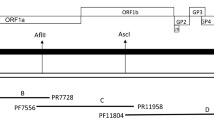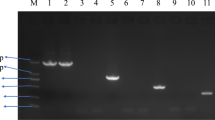Abstract
Non-structural protein 2 (Nsp2) of porcine reproductive and respiratory syndrome virus (PRRSV) is the most variable region and postulated to play an important role in cell and tissue tropism of PRRSV. To investigate the role of Nsp2 in the viability and growth of PRRSV in cells in vitro, two cDNA clones were constructed containing a deletion of 63 consecutive nucleotides (pWSK-DCBAd63) or 117 nucleotides (pWSK-DCBAd117) within the Nsp2-encoding region of PRRSV (BJ-4). The clone pWSK-DCBAd63 was infectious and produced viable recombinant virus, whereas clone pWSK-DCBAd117 could not be rescued. The rescued virus was able to induce CPE typical of PRRSV on MARC-145 cells and was stably propagated during sequential in vitro cell passages, like the virus recovered from the full-length cDNA clone of PRRSV BJ-4. In comparison to the parental virus (BJ-4) and the virus recovered from the full-length cDNA clone of the BJ-4 strain, the rescued virus from pWSK-DCBAd63 exhibited enhanced growth kinetics, reaching the peak progeny virus titer by 48 h postinfection. These observations suggest that the Nsp2-encoding region is necessary for productive virus infection, and partial deletion does not influence the viability and propagation of PRRSV in cell culture, which may provide a way to insert a foreign gene into the viral genome as a marker for differentiation.




Similar content being viewed by others
References
Albina E (1997) Epidemiology of porcine reproductive and respiratory syndrome (PRRS): an overview. Vet Microbiol 55:309–316
Allende R, Lewis TL, Lu Z, Rock DL, Kutish GF, Ali A, Doster AR, Osorio FA (1999) North American and European porcine reproductive and respiratory syndrome viruses differ in non-structural protein coding regions. J Gen Virol 80:307–315
Bautista EM, Meulenberg JJ, Choi CS, Molitor TW (1996) Structural polypeptides of the American (VR-2332) strain of porcine reproductive and respiratory syndrome virus. Arch Virol 141:1357–1365
Bautista EM, Faaberg KS, Mickelson D, McGruder ED (2002) Functional properties of the predicted helicase of porcine reproductive and respiratory syndrome virus. Virology 298:258–270
Benfield DAE, Nelson E, Collins JE, Harris L, Goyal SM, Robison D, Christianson WT, Morrison RB, Gorcyca DE, Chladek DW (1992) Characterization of swine infertility and respiratory syndrome (SIRS) virus (isolate ATCC-VR2332). J Vet Diagn Invest 4:127–133
Botner A, Nielsen J, Bille-Hansen V (1994) Isolation of porcine reproductive and respiratory syndrome (PRRS) virus in a Danish swine herd and experimental infection of pregnant gilts with the virus. Vet Microbiol 40:351–360
Boyer JC, Haenni AL (1994) Infectious transcripts and cDNA clones of RNA viruses. Virology 198:415–426
Cavanagh D (1997) Nidovirales: a new order comprising Coronaviridae and Arteriviridae. Arch Virol 142:629–633
Chen XY, Yang HC, Guo X (2005) Construction of full-length cDNA of porcine reproductive and respiratory syndrome virus BJ-4 strain. J Agric Biotechnol 13:61–65 (in Chinese with English abstract)
Collins JE, Benfield DA, Christianson WT, Harris L, Hennings JC, Shaw DP, Goyal SM, McCullough S, Morrison RB, Joo HS (1992) Isolation of swine infertility and respiratory syndrome virus (isolate ATCC VR-2332) in North America and experimental reproduction of the disease in gnotobiotic pigs. J Vet Diagn Investig 4:117–126
Conzelmann KK, Visser N, van Woensel P, Tiel HJ (1993) Molecular characterization of porcine reproductive and respiratory syndrome virus, a member of the Arterivirus group. Virology 193:329–339
Den Boon JA, Faaberg KS, Meulenberg JJ, Wassenaar AL, Plagemann PG, Gorbalenya AE, Snijder EJ (1995) Processing and evolution of the N-terminus region of the arterivirus replicase ORF1a protein: identification of two pepain-like cysteine proteases. J Virol 69:4500–4505
Fang Y, Kim DY, Ropp S, Steen P, Christopher-Hennings J, Nelson EA, Rowland RRR (2004) Heterogeneity in Nsp2 of European-like porcine reproductive and respiratory syndrome viruses isolated in the United States. Virus Res 100:229–235
Gao ZQ, Guo X, Yang HC (2004) Genetic characterization of two Chinese isolates of porcine reproductive and respiratory syndrome virus. Arch Virol 149:1341–1351
Groot Bramel-Verheije MH, Rottier PJM, Meulenberg JJM (2000) Expression of a foreign epitope by porcine reproductive and respiratory syndrome virus. Virology 278:380–389
Hopper V, White ME, Twiddy N (1992) An outbreak of blue-eared pig disease (porcine reproductive and respiratory syndrome) in four pig herds in Great Britain. Vet Rec 131:140–144
Keffaber KK (1989) Reproductive failure of unknown etiology. Am Assoc Swine Pract Newslett 1:1–9
Kuwahara H, Nunoya T, Tajima M, Kato A, Samejima T (1994) An outbreak of porcine reproductive and respiratory syndrome in Japan. J Vet Med Sci 56:901–909
Lee C, Calvert JG, Welch SKW, Yoo D (2005) A DNA-launched reverse genetics system for porcine reproductive and respiratory syndrome virus reveals that homodimerization of the nucleocapsid protein is essential for virus infectivity. Virology 331:47–62
Meng XJ, Paul PS, Halbur PG (1994) Molecular cloning and nucleotide sequence of the 3’-terminus genomic RNA of the porcine reproductive and respiratory syndrome virus. J Gen Virol 75:1795–1801
Mengeling WL, Vorwald AC, Lager KM, Brockmeier SL (1996) Diagnosis of porcine reproductive and respiratory syndrome using infected alveolar macrophages collected from live pigs. Vet Microbiol 49:105–115
Meulenberg JJM, Petersen-den Besten A, De Kluyver EP, Moormann RJM, Schaaper WMM, Wensvoort G (1995) Characterization of proteins encoded by ORFs 2 to 7 of Lelystad virus. Virology 206:155–163
Meulenberg JJM, Bos-de Ruijter JNA, van de Graaf R, Wensvoort G, Moormann RJM (1998) Infectious transcripts from cloned genome-length cDNA of porcine reproductive and respiratory syndrome virus. J Virol 72:380–387
Meulenberg JJM, Hulst MM, de Meijer EJ, Moonen PLJM, den Besten A, de Kluyver EP, Wensvoort G, Moormann RJM (1993) Lelystad virus, the causative agent of porcine epidemic abortion and respiratory syndrome (PEARS) is related to LDV and EAV. Virology 192:62–74
Moser C, Stettler P, Tratschin JD, Hofmann MA (1999) Cytopathogenic and noncytopathogenic RNA replicons of classical swine fever virus. J Virol 73:7787–7794
Murtaugh MP, Elam MR, Kakach LT (1995) Comparison of the structural protein coding sequences of the VR-2332 and Lelystad virus strains of the PRRS virus. Arch Virol 140:1451–1460
Nelsen CJ, Murtaugh MP, Faaberg KS (1999) Porcine reproductive and respiratory syndrome virus comparison: divergent evolution on two continents. J Virol 73:270–280
Nelson EA, Christopher-Hennings J, Drew T, Wensvoort G, Collins JE, Benfield DA (1993) Differentiation of U.S. and European isolates of porcine reproductive and respiratory syndrome virus by monoclonal antibodies. J Clin Microbiol 31:3184–3189
Neumann EJ, Kliebenstein JB, Johnson CD, Mabry JW, Bush EJ, Seitzinger AH, Green AL, Zimmerman JJ (2005) Assessment of the economic impact to porcine reproductive and respiratory syndrome on swine production in the United States. J Am Vet Med Assoc 227:385–392
Nielsen HS, Liu G, Nielsen J, Oleksiewicz MB, Botner A, Storgaard T, Faaberg KS (2003) Generation of an infectious clone of VR-2332, a highly virulent North American-type isolate of porcine reproductive and respiratory syndrome virus. J Virol 77:3702–3711
Oleksiewicz MB, Botner A, Toft P, Normann P, Storgaard T (2001) Epitope map** porcine reproductive and respiratory syndrome virus by phage display: the nsp2 fragment of the replicase polyprotein contain a cluster of B-cell epitopes. J Virol 75:3277–3290
Pejsak Z, Stadejek T, Markowska-Daniel I (1997) Clinical signs and economic losses caused by porcine reproductive and respiratory syndrome virus in a large breeding farm. Vet Microbiol 55:317–322
Ropp SL, Wees CEM, Fang Y, Nelson EA, Rossow KD, Bien M, Arndt B, Preszler S, Steen P, Chirstopher-Hennings J, Collins JE, Benfield DA, Faaberg KS (2004) Characterization of emerging European-like porcine reproductive and respiratory syndrome virus isolates in the United States. J Virol 78:3684–3703
Rossow KD (1998) Porcine reproductive and respiratory syndrome. Vet Pathol 35:1–20
Sambrook J, Russell DW (2001) Molecular cloning: a laboratory manual, 3rd edn. Cold Spring Harbor Laboratory, New York
Shen S, Kwang J, Liu W, Liu DX (2000) Determination of the complete nucleotide sequence of a vaccine strain of porcine reproductive and respiratory syndrome virus and identification of the Nsp2 gene with a unique insertion. Arch Virol 145:871–883
Snijder EJ, Wassenaar ALM, van Dinten LC, Spaan WJM, Gorbalenya AE (1996) The arteriviruses Nsp4 protease is prototype of a novel group of chymotrypsin-like enzymes, the 3C-like serine proteases. J Biol Chem 271:4864–4871
Snijder EJ, Wassenaar ALM, Spann WJM, Gorbalenya AE (1995) The arteriviruses Nsp2 protease. An unusual cysteine protease with primary structure similarities to both papain-like and chymotrypsin-like protease. J Biol Chem 270:16671–16676
Snijder EJ, Meulenberg JJM (1998) The molecular biology of arteriviruses. J Gen Virol 79:961–979
Truong HM, Lu Z, Kutish GF, Galeota J, Osorio FA, Pattnaik AK (2004) A highly pathogenic porcine reproductive and respiratory syndrome virus generated from an infectious cDNA clone retains the in vivo virulence and transmissibility properties of the parental virus. Virology 325:308–319
Van Dinten LC, Wassenaar ALM, Gorbalenya AE, Spann WJM, Snijder EJ (1996) Processing of Equine arterivirus replicase ORF1b protein: identification of cleavage products containing the putative viral polymerase and helicase domains. J Virol 70:6625–6633
Verheije MH, Kroese MV, van der Linden IFA, de Boer-Luijtze EA, van Rijn PA, Pol JMA, Meulenberg JJM, Steverink PJGM (2003) Safety and protective efficacy of porcine reproductive and respiratory syndrome recombinant virus vaccines in young pigs. Vaccine 21:2556–2563
Welch SKW, Jolie R, Pearce DS, Koertje WD, Fuog E, Shields SL, Yoo D, Calvert JG (2004) Construction and evaluation of genetically engineered replication-defective porcine reproductive and respiratory syndrome virus vaccine candidates. Vet Immunol Immunopathol 102:277–290
Wensvoort G, Terpstra C, Pol JMA, ter Laak EA, Bloemraad M, de Kluyver EP, Kragten C, van Buiten L, den Besten A, Wagenaar F, Broekhuijsen JM, Moonen PLJM, Zetstra T, de Boer EA, Tibben HJ, de Jong MF, van’t Veld P, Groenland GJR, van Gennep JA, Voets MT, Verheijden JHM, Braamskamp J (1991) Mystery swine disease in the Netherlands: the isolation of Lelystad virus. Vet Q 13:121–130
Yang HC, Huang FF, Guo X, Gao Y, Li H, Chen S (2001) Sequencing of genome of porcine reproductive and respiratory syndrome virus isolate BJ-4. J Agricult Biotechnol 9:212–218 (in Chinese with English abstract)
Yang HC, Guan SH, Yin XM, Gan MH (1997) Isolation and identification of porcine reproductive and respiratory syndromes virus Chin J Vet Med 23(10):9–10 (in Chinese)
Yoo D, Welch SKW, Lee C, Calvert JG (2004) Infectious cDNA clones of porcine reproductive and respiratory syndrome virus and their potential as vaccine vectors. Vet Immunol Immunopathol 102:143–154
Acknowledgments
This study was supported by a National Key Basic Research Plan Grant (#2005CB523204), National 863 Program (Grant No.2006AA10A204) and National Key Technology R&D Program of China (Grant No. 2006BAD06A03) from Chinese Ministry of Science and Technology.
Author information
Authors and Affiliations
Corresponding authors
Additional information
Hanchun Yang and Kyoung-** Yoon are equal contribution corresponding authors.
Rights and permissions
About this article
Cite this article
Ran, Z.G., Chen, X.Y., Guo, X. et al. Recovery of viable porcine reproductive and respiratory syndrome virus from an infectious clone containing a partial deletion within the Nsp2-encoding region. Arch Virol 153, 899–907 (2008). https://doi.org/10.1007/s00705-008-0064-3
Received:
Accepted:
Published:
Issue Date:
DOI: https://doi.org/10.1007/s00705-008-0064-3




